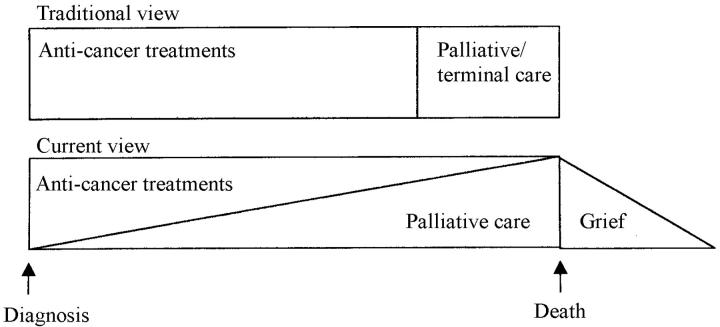The diagrams opposite, taken from Professor Finaly's article on p. 437, illustrate two visions of palliative care. In the rectangle, palliative care begins only when attempts at cure have been abandoned. This was the model applied by Medicare in the USA for its hospice benefit: if a patient was to qualify, his or her doctor had to certify that life expectancy was six months or less, and the patient had to accept that only palliative care would be offered. Uptake under the scheme, introduced in 1983, was greatly limited by these two stipulations. Cancer was overrepresented among the beneficiaries, many of whom died soon after acceptance on the programme. In the UK, the hospice programme has likewise been criticized for an overemphasis on cancer, though not for admitting patients too late. A newer vision is represented by the triangle, in which palliative care merges seamlessly with attempts at cure. Though the label on this diagram says cancer, the principle applies to a multitude of other diseases. The whole of medicine needs to reflect upon good palliative care.
Figure 1.
This issue of the JRSM is entirely given over to material from a conference hosted by the RSM last December and sponsored by the Health Resources and Services Administration, US Department of Health and Human Services. With its focus on HIV/AIDS, I was originally doubtful about the interest of the papers to a multispecialty readership and planned to publish them as a supplement for limited distribution. But I came to think that, with many of the important ideas applicable across the specialties, the papers deserved the wider readership of the Journal proper. I leave it to Dr O'Neill and Professor Higginson to explain, on p. 429, the thinking behind the conference. The main conclusions can be found overleaf. For readers who like to start in the middle, I warmly recommend the article by Dr Hillier and Dr Wee on p. 468.



